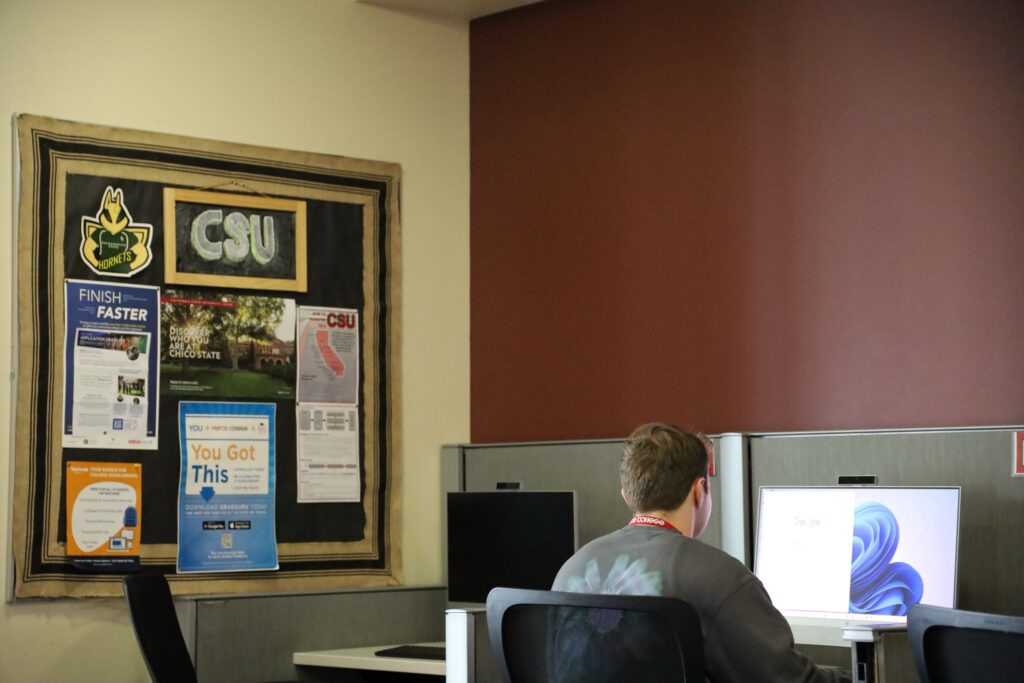
Credit: Delilah Brumer/EdSource
From complex general education requirements to early application deadlines, transferring from community college to California State University, Northridge proved to be a confusing process for Vanessa Rivera. Now, as a graduate intern at the Los Angeles Pierce College transfer center, Rivera works to support other students on their paths to the CSU system.
“I was a lost college student, and I was really intimidated to seek help,” Rivera said. “This led me to a career path in counseling, (for the) ability to benefit lost college students like I once was.”
With hopes of helping ease the transfer process for students like Rivera, the CSU system opened its new online CSU Transfer Planner for all California community college students in January.
“A large gap exists between the number of students who intend to transfer, and those who do,” said April Grommo, assistant vice chancellor of strategic enrollment management at the CSU Chancellor’s Office.
A complicating factor has been the lack of standards between systems. For example, the University of California has not had a systemwide transfer guarantee for community college students, and students considering transferring to Cal State have separate and different requirements for that system.
According to an August 2023 report from the Public Policy Institute of California, only 19% of community college students who intended to transfer did so within four years, and only 10% did so within two years. Grommo said she hopes the new transfer portal will help bridge that gap.
“The CSU Transfer Planner was designed to create a more efficient and accessible pathway for students to transfer to the CSU,” Grommo said.
The planner allows students to map out their coursework and general education requirements, enter test scores, view articulation agreements, explore program offerings and check if their GPA meets the requirements at their target campuses.
According to Grommo, the tool is tailored to help students figure out their individual paths so they don’t waste time and money taking unnecessary courses.
“With the CSU Transfer Planner, community college students can directly connect to their future CSU campus of choice early in their educational journey, and ultimately minimize credit-loss and maximize time-to-degree completion,” Grommo said.
As of the end of February — less than three months after the portal launched — more than 9,500 students had created Transfer Planner accounts, according to Grommo.
The planner is a great tool for students but has yet to see widespread use because of how new it is, according to Sunday Salter, the transfer center director at Pierce College and a member of the CSU Transfer Planner implementation committee.
“We want students to have some certainty,” Salter said. “A lot of students feel unsure in the transfer process. Our hope is that this tool will help them feel really confident in what is expected of them.”
Samantha Watanabe, a third-year liberal studies major who recently transferred from Cuesta College to Cal Poly San Luis Obispo, said a program like this would have really helped her while she was transferring.
“My last semester, I had to take seven classes just to get into Cal Poly because I wasn’t paying attention and didn’t really know that there were other requirements for Cal Poly. So I think a program like (the transfer planner) would have definitely aided me,” Watanabe said.
Navigating transfer requirements is a difficult task for students across the nation. In Virginia, a new dual-admission program is working to address this problem and might ultimately serve as a model for California’s university systems.
The CSU and UC systems also have recently launched dual-admission programs. First-time freshmen entering a community college can apply for the CSU Transfer Success Pathway program through the transfer portal.
Transfer center counselor Ashley Brackett at Allan Hancock College said she is excited about the planner, noting that it provides a huge opportunity for students.
“I’m stoked that they finally have created something similar to what the UC has already had for a really long time,” Brackett said.
The University of California system has a similar online planner for community college students to track their progress and requirements for admission to a UC.
The UC Transfer Admission Planner is connected to the UC application, allowing students to keep track of their progress and apply for their school of choice all in one place, according to the UC admissions page.
The CSU planner will eventually be connected to the CSU application just like the UC planner is connected to its application, according to Grommo.
As the planner continues to develop, Salter said the Pierce transfer center will host events to introduce it to students who apply for the next CSU admission cycle, which will begin in October.
“I’m really excited that the Cal States have done this,” Salter said. “It centralizes communication between the universities and the students, and I’m looking forward to watching it expand.”
Ashley Bolter is a fourth-year journalism student minoring in French and ethnic studies at Cal Poly. Delilah Brumer is a sophomore at Los Angeles Pierce College majoring in journalism and political science. Both are members of EdSource’s California Student Journalism Corps.


